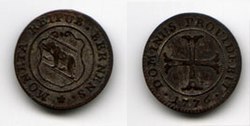Kreuzer
This article needs additional citations for verification. (May 2007) |


The Kreuzer (German: [ˈkʀɔɪtsɐ] ), in English usually kreutzer,[1] was a silver coin and unit of currency existing in the southern German states prior to the unification of Germany, and in Austria. After 1760 it was made of copper.[2]
Early history
In 1559 a value of 60 Kreuzer to 1 gulden had been adopted throughout the Southern states of the Holy Roman Empire, but the northern German states declined to join, and used Groschen instead of Kreuzer. The Kreuzer in turn was worth about 4.2 Pfennig, or pennies. Thus one (golden) Gulden was worth 60 Kreuzer, or 252 Pfennig. Later currencies adopted a standard relationship of 240 Pfennig = 60 Kreuzer = 1 Gulden.
Conventionsmünze
Following the adoption of the Conventionsthaler in 1754, two distinct Kreuzer came into being. The first, sometimes referred to as the Conventionskreuzer, was worth 1/120 of a Conventionsthaler, valuing the gulden at half a Conventionsthaler. This was used in Austria-Hungary. However, the states of southern Germany adopted a smaller Kreuzer Landmünze worth 1/144 of a Conventionsthaler, thus valuing the Gulden at 5/12 of a Conventionsthaler. In fact, the southern German states issued coins denominated in Kreuzer Landmünze up to 6 Kreuzer Landmünze (equal to 5 Conventionskreuzer) but in Conventionskreuzer for higher denominations.
South Germany 1837–1873
The South German Currency Union of 1837 used a system of 60 Kreuzer = 1 Gulden and 1¾ Gulden = 1 Thaler, with the Kreuzer equal to the old Kreuzer Landmünze. These Kreuzer continued in circulation until decimalization, following German unification.
Austria-Hungary 1857–1892
Austria-Hungary decimalized in 1857, adopting a system of 100 Kreuzer = 1 Gulden, Austrian Florin or Hungarian forint, 1½ gulden = 1 Vereinsthaler. It was known in Hungarian as krajczár (in modern Hungarian orthography: krajcár), in Czech as krejcar, in Slovak as grajciar, in Slovene as krajcar, and in Romanian as creiţar or crăiţar.
